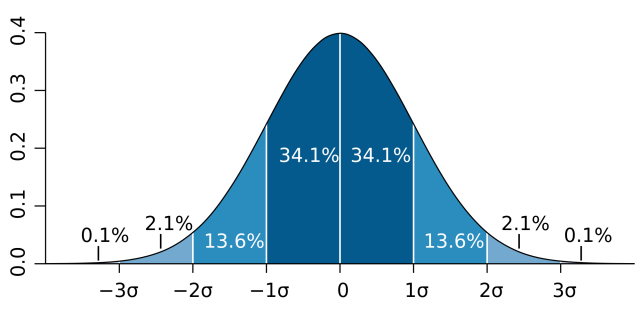My statistics teacher showed us this video in class about the Central Limit Theorem, which is the most important theorem in statistics. Basically, it states that with a large sample, the sampling distribution of the means is normally distributed. This is always the case, even when the sample is not originally distributed; the sample can be bimodal or even uniform.
The normal curve, or bell curve, is one of the most recognizable distributions and the most common. Just a refresher, this is what a normal curve looks like:

The highest point of the curve is the mean, median, and mode of a sample. 68% of observations are within 1 standard deviation from the mean, with the standard deviation being the average variation from the mean. For example, if a newborn kitten weighs an average of 4 ounces with a standard deviation of 1 oz, then 68% of newborn kittens would be 3-5 oz. This would be under the assumption that newborn kitten weights are normally distributed. I have no idea if that’s true… I just really like kittens.
According to the Central Limit Theorem, if you take many samples of newborn kitten weight, the distribution should look like a normal curve, regardless of whether it actually is normally distributed.
Rather than explaining the Central Limit Theorem in depth, I would highly recommend the video by Creature Cast. The script is by Casey Dunn and Shuyi Chiou, and it was posted on the New York Times‘ YouTube channel in 2013.
The video explains the theorem so simply and with excellent graphics. Compared to other videos on the Central Limit Theorem, it’s much shorter (and more entertaining, who doesn’t love bunnies and dragons?) while still covering the fundamentals of the theorem. The explanation is clear and simple so that introductory statistics students, and even those who don’t have any statistics education, can understand and grasp the ideas.
If you’re a student who is struggling to understand the Central Limit Theorem or just someone looking to learn a little bit more about the world around them, this is the video for you!
